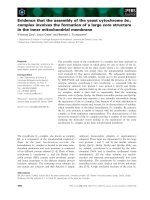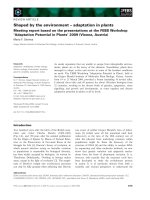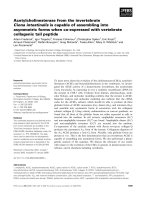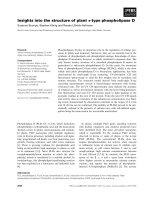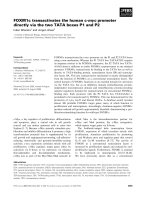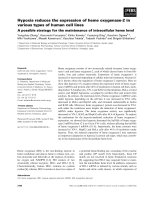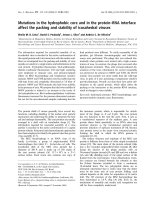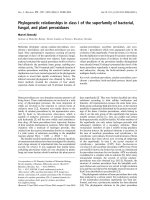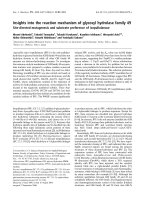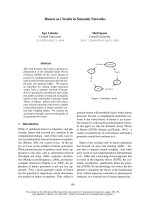Báo cáo khoa học: Expressed as the sole Hsp90 of yeast, the a and b isoforms of human Hsp90 differ with regard to their capacities for activation of certain client proteins, whereas only Hsp90b generates sensitivity to the Hsp90 inhibitor radicicol pdf
Bạn đang xem bản rút gọn của tài liệu. Xem và tải ngay bản đầy đủ của tài liệu tại đây (744.99 KB, 11 trang )
Expressed as the sole Hsp90 of yeast, the a and b isoforms
of human Hsp90 differ with regard to their capacities for
activation of certain client proteins, whereas only Hsp90b
generates sensitivity to the Hsp90 inhibitor radicicol
´
Stefan H. Millson1, Andrew W. Truman1, Attila Racz2, Bin Hu3, Barry Panaretou3, James Nuttall1,
Mehdi Mollapour1, Csaba Soti2 and Peter W. Piper1
ă
1 Department of Molecular Biology and Biotechnology, The University of Sheffield, UK
2 Department of Medical Chemistry, Semmelweis University, Budapest, Hungary
3 Division of Life Sciences, King’s College London, UK
Keywords
chaperone inhibitor; human heat shock
protein 90 chaperone; isoforms of heat
shock protein 90; radicicol; yeast expression
Correspondence
P. W. Piper, Department of Molecular
Biology and Biotechnology, The University
of Sheffield, Firth Court, Western Bank,
Sheffield, S10 2TN, UK
Fax: +44 114 222 2800
Tel: +44 114 222 2851
E-mail: Peter.Piper@sheffield.ac.uk
(Received 24 April 2007, revised 1 June
2007, accepted 3 July 2007)
doi:10.1111/j.1742-4658.2007.05974.x
Heat shock protein 90 (Hsp90) is a molecular chaperone required for the
activity of many of the most important regulatory proteins of eukaryotic
cells (the Hsp90 ‘clients’). Vertebrates have two isoforms of cytosolic
Hsp90, Hsp90a and Hsp90b. Hsp90b is expressed constitutively to a high
level in most tissues and is generally more abundant than Hsp90a, whereas
Hsp90a is stress-inducible and overexpressed in many cancerous cells.
Expressed as the sole Hsp90 of yeast, human Hsp90a and Hsp90b are both
able to provide essential Hsp90 functions. Activations of certain Hsp90
clients (heat shock transcription factor, v-src) were more efficient with
Hsp90a, rather than Hsp90b, present in the yeast. In contrast, activation
of certain other clients (glucocorticoid receptor; extracellular signal-regulated kinase-5 mitogen-activated protein kinase) was less affected by the
human Hsp90 isoform present in these cells. Remarkably, whereas expression of Hsp90b as the sole Hsp90 of yeast rendered cells highly sensitive to
the Hsp90 inhibitor radicicol, comparable expression of Hsp90a did not.
This raises the distinct possibility that, also for mammalian systems, alterations to the Hsp90a ⁄ Hsp90b ratio (as with heat shock) might be a significant factor affecting cellular susceptibility to Hsp90 inhibitors.
Heat shock protein 90 (Hsp90), an essential molecular
chaperone, catalyzes the final activation step of many
of the key regulatory proteins in eukaryotic cells (the
Hsp90 ‘clients’). The list of proteins that are Hsp90
clients is impressive and ever-expanding (reviewed in
[1,2]). It includes several of the
important determinants of multistep carcinogenesis,
such as ERBB2, C-RAF, CDK4, AKT ⁄ PKB, steroid
hormone receptors, mutant p53, HIF-1a, survivin and
telomerase (hTERT). Genomic studies in yeast have
recently addressed the breadth of the Hsp90 clientele,
revealing that up to 10% of the proteome may be subject to Hsp90 regulation [3,4].
Most simple eukaryotes have only a single form of
cytosolic Hsp90 (e.g. Drosophila [5] and Caenorhabditis
elegans [6]). Although budding yeast (Saccharomyces
cerevisiae) has two isoforms of cytosolic Hsp90, one
constitutively expressed at high level (Hsc82) and the
other strongly heat-inducible (Hsp82) [7], these
most probably arose as the result of the ancestral
Abbreviations
AD, activator domain; BD, DNA-binding domain; CT, C-terminal activator ⁄ modulator; DO, complete dropout glucose medium; ERK,
extracellular signal-regulated kinase; GR, glucocorticoid receptor; HSF, heat shock transcription factor; Hsp90, heat shock protein 90;
MAP kinase, mitogen-activated protein kinase; v-src, v-src tyrosine kinase; Y2H, yeast two-hybrid.
FEBS Journal 274 (2007) 4453–4463 ª 2007 The Authors Journal compilation ª 2007 FEBS
4453
Human Hsp90a and Hsp90b expressed in yeast
S. H. Millson et al.
duplication of the S. cerevisiae genome [8], as most
yeast species have just a single Hsp90.
Vertebrates also have two major forms of cytosolic
Hsp90 (Hsp90a; Hsp90b), isoforms that are generally
around 85% identical in amino acid sequence [9,10].
Hsp90b is expressed constitutively to a higher level
than Hsp90a in most tissues and is important for longterm cellular adaptation, differentiation, and evolution.
The other isoform, Hsp90a (in humans, a form with
86% identity and 93% similarity in sequence to
Hsp90b), is generally stress-inducible and may therefore be a more cytoprotective form of Hsp90 [11].
Hsp90a is also expressed to high level in many cancers
[9], as well as extracellularly, where its effects on the
activity of metalloproteinase 2 may be important in
cancer cell metastasis [12].
Although the differential patterns of expression of
Hsp90a and Hsp90b suggest that these isoforms may
not be completely equivalent in function, there is as
yet no firm genetic evidence for a functional difference
between Hsp90a and Hsp90b [11]. During the heat
shock response, many mammalian cell types display
strong heat shock transcription factor (HSF)-directed
induction of Hsp90a. This induction of Hsp90a will
increase the a ⁄ b isoform ratio, an increase that might
be a significant factor in Hsp90-dependent actions [13].
In the yeast heat shock response, HSF-directed elevation of Hsp90 level is required in order to facilitate the
activation of an Hsp90 client protein kinase needed for
high-temperature growth [14]. This kinase, in turn,
activates a transcription factor responsible for a significant fraction of the non-HSF-dependent events of gene
induction in yeast subjected to heat shock stress [14].
The human genome appears to have just two functional genes for Hsp90a and one for Hsp90b [10]. So
essential is the Hsp90 function conferred by these genes
that it is possible that neither Hsp90a nor Hsp90b can
be inactivated completely in vertebrate systems, creating a situation where the remaining isoform would have
to provide all the essential functions for cytosolic
Hsp90. Hsp90b loss is known to cause embryonic
lethality in the mouse [15]. Whereas it might be feasible
to generate Hsp90a or Hsp90b gene knockouts in
particular animal tissues, it is not clear whether this is a
realistic strategy for revealing any functional differences between the isoforms. We have therefore investigated yeast strains that express, to similar levels, either
human Hsp90a or human Hsp90b as their sole Hsp90.
Here we report a study of the activation of various
Hsp90 clients and Hsp90 inhibitor sensitivity in such
strains; analysis that showed that many mammalian
clients are able to be activated by both Hsp90a and
Hsp90b. Whether Hsp90a or Hsp90b is expressed in
4454
the yeast, however, has a dramatic effect on Hsp90
inhibitor sensitivity. This raises the intriguing possibility that the a ⁄ b isoform ratio may be an important
determinant of such inhibitor sensitivity in mammalian
cells. In an independent study, yeasts expressing either
Hsp90a or Hsp90b were recently used to study the
effects of some naturally occurring sequence polymorphisms in the human genes for Hsp90 [16].
Results
PP30[hHsp90a] and PP30[hHsp90b] ) yeast strains
that express human Hsp90a or Hsp90b as their
sole Hsp90
S. cerevisiae strains PP30[pHSC82b], PP30[pHSP82]
and PP30[hHsp90b] are hsc82D hsp82D double mutant
cells that express, from a plasmid-borne Hsp90 gene,
either the native yeast Hsc82, the native yeast Hsp82 or
human Hsp90b as their sole, essential Hsp90 [17]. For
the current study, we constructed in this genetic background an additional strain in which the Hsp90 present
is human Hsp90a (PP30[hHsp90a]; see Experimental
procedures). Western blotting using an antiserum that
recognizes, with comparable efficiencies, both of the
yeast and both of the human isoforms of Hsp90 indicated that the levels of Hsp90 expression in strains
PP30[pHSC82b], PP30[pHSP82], PP30[hHsp90a] and
PP30[hHsp90b] were comparable, although the Hsp90b
expression of PP30[hHsp90b] appeared to be slightly
lower than that of the other three strains (Fig. 1A). These
yeasts, isogenic but for their Hsp90 gene, might therefore
be expected to exhibit similar phenotypes. Nevertheless,
as the studies below reveal, the strains expressing
human Hsp90a or Hsp90b do exhibit some differences.
These isoforms are therefore not completely identical
in their in vivo actions, at least when expressed in yeast.
Phenotypic differences between strains
PP30[hHsp90a] and PP30[hHsp90b]
Investigating the properties of the strains expressing
human Hsp90a or human Hsp90b as their sole Hsp90,
we found no defect in respiratory growth, cell wall
integrity or the ability to withstand osmostress (properties defective in certain Hsp90 mutants of yeast
[3,14,18,19]; unpublished data). Both strains were
growth-arrested when exposed to the mating pheromone a-factor (data not shown), and so were not defective in this Hsp90-dependent response [20]. Also, when
rendered histidine prototrophic through the introduction of an HIS3 vector, both PP30[hHsp90a] and
PP30[hHsp90b] grew well at 30 °C in the presence of
FEBS Journal 274 (2007) 4453–4463 ª 2007 The Authors Journal compilation ª 2007 FEBS
S. H. Millson et al.
A
B
C
Fig. 1. (A) Measurement of the relative levels of Hsp90 expression
in strains PP30[pHSC82b], PP30[pHSP82], PP30[hHsp90a], and
PP30[hHsp90b]. Ten micrograms of total soluble protein was gel
fractionated, and then western blotted; the blot was then probed
with anti-(Achlya Hsp90) monoclonal serum. The bands indicated by
an asterisk correspond to a slightly degraded, N-terminally truncated form of Hsp90 that is often present in total cell extracts of
yeast [45]. (B) Levels of HSE2-LacZ reporter gene activity in strain
PSY145* with wild-type Hsf1p [22] (hatched bars) or strain
PSY145*HSF(1–583) with a CT domain-deficient Hsf1p [22] (open
bars), showing that heat induction of HSE2-LacZ is dependent on
the Hsf1p CT domain. (C) Measurements of HSE2-LacZ expression
in strains PP30[pHSP82], PP30[pHSC82b], PP30[hHsp90a], and
PP30[hHsp90b]; cultures either in growth at 25 °C (–) or heat
shocked from 25 °C to 37 °C for 1 h (+). Measurements in (B) and
(C) are the mean and SD of eight separate assays on each culture.
30 mm 3-aminotriazole. They are therefore not defective
in the Hsp90-dependent activation of Gcn2p kinase [21].
In contrast, the strain expressing Hsp90b was slightly
temperature-sensitive [PP30[hHsp90a], and exhibited
growth on YPD to 39–40 °C, whereas PP30[hHsp90b]
grew only to 36–37 °C (not shown)]. Growth of S. cerevisiae at high temperature requires the activity of the
C-terminal activator ⁄ modulator (CT) domain of yeast
HSF (Hsf1p). Cells expressing a CT domain-deficient
Hsf1p exhibit no growth above 35 °C. This high-temperature growth defect is rescued by Hsp90 overexpression,
revealing that this growth defect is primarily due to the
Human Hsp90a and Hsp90b expressed in yeast
low level of (Hsf1p-directed) Hsp90 expression in these
cells [14,22].
To find whether heat activation of the Hsf1p CT
domain is defective in our strains expressing a single
Hsp90 isoform (all strains with a wild-type Hsf1p), we
monitored a reporter gene (HSE2-lacZ [23]) that measures activity of the Hsf1p CT domain (HSE2-lacZ
heat activation is completely lost in a yeast mutant
that expresses normal Hsp90 but a CT domain-deficient HSF; see Fig. 1B). We found efficient HSE2-lacZ
activation by heat shock in cells expressing either the
native yeast Hsp82 or Hsc82, or the human Hsp90a
(PP30[pHSC82b], PP30[pHSP82], and PP30[hHsp90a],
respectively), but only moderate HSE2-lacZ activation
in the identically stressed PP30[hHsp90b] (Fig. 1C).
The induction of CT domain activity by heat stress is
therefore less efficient with Hsp90b as compared to
Hsp90a present in the yeast. As temperature sensitivity
is normally associated with compromised activity of
the Hsf1p CT domain [14,22], the compromised heat
activation of this domain with Hsp90b present in the
yeast (Fig. 1C) is a plausible explanation for the moderate degree of temperature sensitivity exhibited by
strain PP30[hHsp90b].
Activation of mammalian Hsp90 clients by either
Hsp90a or Hsp90b expressed in yeast
We were interested in whether mammalian Hsp90 clients would display any differences in activation when
expressed in the PP30[hHsp90a] and PP30[hHsp90b]
yeast strains, differences that might indicate a functional nonequivalence of human Hsp90a and Hsp90b.
We therefore expressed in these strains three vertebrate
Hsp90 clients whose activities are known to be Hsp90dependent when expressed in yeast (client proteins,
therefore, that have already been demonstrated to be
activated by the native Hsp90s of yeast): glucocorticoid
receptor (GR) [24], v-src tyrosine kinase (v-src) [25],
and extracellular signal-regulated kinase-5 (ERK5)
mitogen-activated protein (MAP) kinase [18].
GR assays indicated that human Hsp90a and
Hsp90b, as well as the native yeast Hsp90s, were all
capable of activating GR in these strains (Fig. 2).
Active v-src expression is normally lethal for yeast,
an organism with very low intrinsic levels of tyrosine
kinase activity [25]. With use of a galactose-inducible
system for v-src expression, high levels of tyrosine
phosphorylation were generated in response to v-src
induction in PP30[hHsp90a] (Fig. 3B); an induction
associated with strong growth inhibition (Fig. 3A). In
contrast, the identically treated culture of strain
PP30[hHsp90b] exhibited much lower levels of tyrosine
FEBS Journal 274 (2007) 4453–4463 ª 2007 The Authors Journal compilation ª 2007 FEBS
4455
Human Hsp90a and Hsp90b expressed in yeast
S. H. Millson et al.
A
B
Fig. 2. Measurements of GR activity in 30 °C cultures of strains
PP30[pHSP82], PP30[pHSC82b], PP30[hHsp90a], and PP30[hHsp90b],
3 h following addition of either 20 lM (open bars) or 50 lM (solid
bars) dexamethosone. The data shown are the mean and SD of
four separate assays on each culture. In the absence of inducer,
activity levels were consistently less than 10 mU (units are defined
as in [43,45]).
phosphorylation (Fig. 3B), and the cells were also relatively much less sensitive to the lethal effects of the
v-src expression (Fig. 3A). Hsp90a, but not Hsp90b,
therefore facilitated the efficient production of active
v-src in these strains.
Although MAP kinases are generally considered to
have non-Hsp90-dependent activities [26], we recently
found that human ERK5 MAP kinase is an Hsp90 client, at least when expressed in active form in yeast
[18]. ERK5 is the human ortholog of the yeast Slt2p
cell integrity MAP kinase (also an Hsp90 client); heterologous expression of ERK5 in yeast completely rescuing the effects of loss of this native Slt2p [3,18].
ERK5 activity in yeast is therefore readily monitored
as the suppression of slt2D mutant phenotypes [18]. To
determine whether ERK5 could still provide the cell
integrity MAP kinase function when, in yeast cells,
either human Hsp90a or Hsp90b replaced the native
Hsp90, we constructed slt2D mutant versions of strains
PP30[hHsp90a] and PP30[hHsp90b] (see Experimental
procedures). These strains (PP30[hHsp90a]slt2D and
PP30[hHsp90b]slt2D) were then transformed with either
a control empty vector or a vector for constitutive
ERK5 expression (pG1 and pG1-ERK5, respectively
[18]), as well as a plasmid bearing the YIL117w-LacZ
reporter gene [27], which monitors the activity of
Rlm1p, a transcription factor activated by cell integrity
MAP kinase.
Loss of cell integrity MAP kinase generates a number of characteristic phenotypes in yeast, including
temperature and caffeine sensitivity [28–30] and loss of
mating projection formation upon treatment with mating pheromones [31]. Plasmid pG1-ERK5 rescues these
4456
Fig. 3. (A) v-src exerts a much stronger dominant-negative effect in
Hsp90a-expressing tha in Hsp90b-expressing yeast. Serial dilution
of either PP30[hHsp90a] or PP30[hHsp90b], transformed either
with empty pRS316 vector or the vector for galactose-inducible
v-src expression, grown for 3 days at 29 °C on DO minus uracil
and galactose plates. (B) Analysis of the levels of protein
tyrosine phosphorylation before (–) or 1 h after (+) transfer of these
PP30[hHsp90a] and PP30[hHsp90b] transformants from glucose to
galactose medium. Detection was with antibody to phosphotyrosine.
phenotypes of slt2D yeast [18]. It was also able to rescue these phenotypes in both PP30[hHsp90a]slt2D and
PP30[hHsp90b]slt2D, the restoration of high-temperature (37 °C) growth being shown in Fig. 4A. Both isoforms of human cytosolic Hsp90 can therefore activate
human ERK5 MAP kinase in yeast.
Rlm1p, the major trans-activator of cell wall genes
in yeast, is activated through Slt2p-catalyzed phosphorylation [27,32,33]. slt2D mutant cells therefore
display a pronounced Rlm1p activity defect. Hsp90 is
required for the rescue of their Rlm1p activity defect
by ERK5 expression, as such rescue is abolished by
the T22I Hsp90 mutation or by Hsp90 inhibitor treatment [18]. As shown in Fig. 4B, ERK5 expression
provided an appreciable rescue of the Rlm1p activity
of PP30[hHsp90a]slt2D and PP30[hHsp90b]slt2D, activity that was increased by two stress inducers of cell
integrity pathway signaling, heat shock and caffeine.
This is yet further evidence that both Hsp90a and
Hsp90b are able to activate human ERK5 expressed
in yeast.
FEBS Journal 274 (2007) 4453–4463 ª 2007 The Authors Journal compilation ª 2007 FEBS
S. H. Millson et al.
Human Hsp90a and Hsp90b expressed in yeast
A
A
B
B
Fig. 4. (A) Growth (3 days in YPD) at either 30 °C or 37 °C of
PP30[hHsp90a]slt2D and PP30[hHsp90b]slt2D cells transformed
with pG1 or pG1-ERK5. (B) Measurements of YIL117c-LacZ expression in PP30[hHsp90a]slt2D (open bars) and PP30[hHsp90b]slt2D
(black bars) transformed with pG1-ERK5, either in growth at 25 °C
(unstressed), heat shocked from 25 °C to 37 °C for 1 h, or exposed
for 1 h to 8 mM caffeine at 25 °C. In the absence of ERK5 expression, expression levels were less than 2 mU.
Two MAP kinase clients show a stronger
interaction with Hsp90b as compared to Hsp90a
Slt2p and ERK5 are Hsp90 client MAP kinases that
both acquire stronger capacity for Hsp90 binding
in vivo when phosphorylated by the upstream MAP
kinase kinase, Mkk1 ⁄ 2p. Their interactions with the
native Hsp90 of yeast are therefore strengthened by
conditions of stress, such as heat shock, that activate
cell integrity pathway signaling to Mkk1 ⁄ 2p [3,14,18].
We used the yeast two-hybrid (Y2H) system to determine the relative strengths of in vivo interaction of
these two MAP kinases with the two isoforms of
human Hsp90. In the yeast Hsp90s, a C-terminal
Gal4p DNA-binding domain (BD) extension preserves
the essential Hsp90 functions in vivo, whereas positioning this BD at the N-terminus of Hsp90 inactivates the
chaperone [34]. We therefore constructed strains that
express Y2H ‘bait’ fusions comprising Hsp90a and
Hsp90b with C-terminal BD extensions (Hsp90a-BD,
Hsp90b-BD; see Experimental procedures). These were
then mated to cells expressing the previously described
Fig. 5. (A) The relative strengths of Hsp90a-BD–AD-Slt2p, Hsp90bBD–AD-Slt2p, Hsp90a-BD–AD-ERK5 and Hsp90b-BD–AD–ERK5
Y2H interactions, both at 30 °C and 1 h following a 30 °C to 39 °C
heat shock. These measurements of interaction-responsive LacZ
expression in strain PJ694 reveal that AD-Slt2p and AD-ERK5 bind
more strongly to Hsp90b-BD than to Hsp90a-BD in this system.
The control cells (all exhibiting less than 0.1 mU b-galactosidase
activity, not shown) were those expressing AD-Slt2p or AD-ERK5
but with empty pBDC vector, as the basal levels of LacZ expression in this system are generally due to the AD fusion [49]. (B)
Determination of Hsp90 associated with nickel resin-retained, wildtype ERK5(1–407)-His12 in extracts from PP30[hHsp90a]slt2D and
PP30[hHsp90b]slt2D cultures, either in growth at 25 °C, or heat
shocked from 25 °C to 39 °C for 1 h. The blots were probed with
anti-(Achlya Hsp90) and anti-tetra-His sera. Control lanes (C) are the
extracts from unstressed, non-ERK5-expressing cultures of the
same strains.
Gal4p activator domain (AD)-Slt2p and AD-ERK5
‘prey’ fusions [3,18]. Expression of the GAL7 promoter-regulated LacZ gene in the resulting diploid
strains, a gene reporter of protein–protein interaction,
was then analyzed. As shown in Fig. 5A, both the
Slt2p and ERK5 MAP kinases displayed stronger
Y2H interactions with Hsp90b than with Hsp90a.
Consistent with Slt2 and ERK5 acquiring an
enhanced capacity for Hsp90 binding in vivo in
response to Mkk1 ⁄ 2-directed phosphorylation of the
MAP kinase activation loop [3,14,18], Y2H interaction
of these MAP kinases with the two isoforms of human
Hsp90 was strengthened by heat shock (Fig. 5A). The
stronger interaction of ERK5 with Hsp90b, relative to
Hsp90a, was then confirmed through an analysis of
extracts of PP30[hHsp90a]slt2D and PP30[hHsp90b]
slt2D cells expressing a functional [18] ERK5(1–407)His12 fusion. More Hsp90b, relative to Hsp90a, was
associated with the nickel resin-retained ERK5(1–407)-
FEBS Journal 274 (2007) 4453–4463 ª 2007 The Authors Journal compilation ª 2007 FEBS
4457
Human Hsp90a and Hsp90b expressed in yeast
S. H. Millson et al.
His12 (Fig. 5B). As this, and the Y2H interactions in
Fig. 5A, essentially reflect the formation of a late-stage
complex of the Hsp90 chaperone cycle [3,14,18], it is
possible that MAP kinase complexes with Hsp90b in
yeast progress more slowly through this chaperone
cycle than do the equivalent complexes with Hsp90a
(see Discussion).
Expression of Hsp90a or Hsp90b markedly affects
cellular sensitivity to the Hsp90 inhibitor radicicol
We recently reported that strain PP30[hHsp90b] is
extremely sensitive to Hsp90 inhibitors [35]. This, however, is not a general effect of human Hsp90 expression in yeast, as the cells expressing Hsp90a were not
sensitized to the Hsp90-targeting antibiotic radicicol.
Instead, strain PP30[hHsp90a] was relatively radicicolresistant, displaying levels of sensitivity comparable to
that of isogenic strains expressing either of the two isoforms of the native yeast Hsp90 (PP30[pHSC82b],
PP30[pHSP82]); Fig. 6A,C,D. Remarkably, low radicicol levels (to 4 lm) were found to increase the final
biomass yields of PP30[pHSP82], relative to the other
strains tested (Fig. 6). In addition, at high temperature
(37 °C as compared to 30 °C), the presence of the
Hsp82 isoform of yeast Hsp90 in these cells rendered
A
B
cells much less susceptible to radicicol inhibition as
compared to comparable expression (Fig. 1A) of the
97% identical Hsc82 (compare Fig. 6B,C). In normal
yeast (although not these engineered strains), Hsp82 is
the strongly heat-inducible isoform of Hsp90, whereas
Hsc82 is constitutively expressed [7]. As far as we are
aware, the data in Fig. 6A–C represent the first evidence of a phenotypic difference generated by comparable expression (Fig. 1A) of the different isoforms of
native Hsp90 in yeast.
With 30 °C 4 lm radicicol treatment of proliferating
PP30[hHsp90b] cells, the cells continued to enlarge, but
their growth totally lacked organization (rhodamine–
phalloidin staining revealed almost instant loss of any
actin organization following Hsp90 inhibitor treatment;
data not shown). After 6 h, many of these cells displayed
an apparent arrest of DNA and vacuolar segregation
between the mother and daughter (Fig. 6D; middle
image). By 24 h, over half had adopted the terminal
phenotype of enlarged, misshapen cells, their elongated
shape being consistent with a general failure of the actomyosin contractile ring formation that normally leads to
cytokinesis (Fig. 6D; left-hand cell cluster in right-hand
image). With such 4 lm radicicol treatment, all of these
phenotypes were displayed by PP30[hHsp90b], but not
the more resistant PP30[hHsp90a] (Fig. 6D). At this
C
D
Fig. 6. (A–C) Only Hsp90b, not Hsp90a, sensitizes yeast to radicicol. Final biomass yields, expressed as a percentage of that of cells with
no inhibitor, for cells expressing just a single isoform of either yeast Hsp90 (r, Hsp82; j, Hsc82) or human Hsp90 (e, Hsp90a; h, Hsp90b),
cultured for 42 h in the presence of (A) 0–4 lM radicicol, 30 °C, (B) 0–50 lM radicicol, 30 °C, or (C) 0–50 lM radicicol, 37 °C. (D) Morphologic
differences between PP30[hHsp90a] and PP30[hHsp90b] cultured for 6 or 24 h at 30 °C in the presence of 4 lM radicicol.
4458
FEBS Journal 274 (2007) 4453–4463 ª 2007 The Authors Journal compilation ª 2007 FEBS
S. H. Millson et al.
radicicol concentration, the latter strain was not arrested
in growth (Fig. 6A,B).
Discussion
In this work, we have investigated how the presence
of Hsp90a or Hsp90b ) as the sole Hsp90 in yeast
cells ) influences both the activation of certain clients
in these cells and cellular sensitivity to the Hsp90
inhibitor radicicol. The most striking finding was that
it is only expression of Hsp90b, not comparable
expression of Hsp90a, which renders yeast highly sensitive to radicicol (Fig. 6). This raises the distinct possibility that, in mammalian systems as well, alterations
to the Hsp90a ⁄ Hsp90b ratio (as with heat shock) may
be a significant factor affecting sensitivity of cells to
Hsp90 inhibitors. Up to now, the Hsp90a ⁄ Hsp90b isoform ratio has never been considered as a possible
influence on Hsp90 drug resistance. Instead, the total
level of the drug target (Hsp90) in cells, and the
amount of this Hsp90 that becomes locked into complexes with client proteins [36] have generally been
considered to be important factors in such resistance.
Nevertheless, the true picture as regards the determinants of Hsp90 drug resistance is considerably more
complicated than this, as studies of yeast mutants have
revealed that altered resistance can arise with mutation
to Hsp90, with altered cochaperone function and with
the loss of plasma membrane drug efflux pumps [35].
The results of this study point to the two isoforms
of human cytosolic Hsp90 differing in the relative efficiencies with which they activate certain Hsp90 clients,
at least in yeast. Cells that express Hsp90b as their sole
Hsp90 are moderately heat-sensitive, which may be
due in part to lowered Hsf1p activity (Fig. 1C). Activations of GR and ERK5 were seemingly efficient with
either Hsp90a or Hsp90b in the yeast (Figs 2 and 4).
In contrast, activation of v-src was clearly compromised with Hsp90b rather than Hsp90a present in the
cells (Fig. 3). Evidently, therefore, Hsp90a engages in
a much more productive chaperone cycle leading to
v-src activation in yeast, as compared to Hsp90b.
Among src tyrosine kinases, v-src exhibits a much
higher dependence on Hsp90 relative to c-src [1,25].
The former is just one of many mutant oncogenic proteins that tend to accumulate as Hsp90-containing
multiprotein complexes in cancer cells; cells that are
often found to be overexpressing Hsp90a at a high
level [36]. Future studies should therefore address
whether diverse oncogenic proteins ) with activities
that often exhibit a high dependence on Hsp90 function ) are, in general, more efficiently activated by
Hsp90a than by Hsp90b.
Human Hsp90a and Hsp90b expressed in yeast
Hsp90 tends to transiently bind its client proteins, in
a chaperone cycle thought to take place over a time
scale of minutes [37,38]. In yeast, Hsp90b undergoes
stronger Y2H interaction with MAP kinase clients than
Hsp90a (Fig. 5). As detection of in vivo protein–protein
interaction by the Y2H approach requires a fairly long
association of ‘bait’ and ‘prey’ fusions in the nucleus of
the living cell, these stronger MAP kinase Y2H interactions with Hsp90b as compared to Hsp90a (Fig. 5A)
are consistent with a longer residence time of these clients in the form of multiprotein complexes in vivo when
associated with Hsp90b as compared to Hsp90a ) an
indication that Hsp90b may progress rather more
slowly through the chaperone cycle than Hsp90a. Y2H
interactions with Hsp90 are generally only detected
when the chaperone cycle is slowed [3].
In mammalian cells, the fraction of the cellular
Hsp90 existing in the form of multiprotein complexes
with client proteins appears to be a major determinant
of Hsp90 drug sensitivity, the high sensitivity of certain
cancer cells to these drugs apparently being associated
with the large pool of mutant client proteins sequestering much of the Hsp90 into Hsp90–client complexes
[36]. Thus, the high radicicol sensitivity of
PP30[hHsp90b] relative to the other strains tested
(Fig. 6) may, in part, be due to a higher Hsp90 fraction in this strain existing as multichaperone complexes
with high affinity for client proteins, rather that as the
latent uncomplexed chaperone.
The ATPase reaction of Hsp90 is thought to constitute the rate-limiting step of the Hsp90 chaperone cycle
in vivo, ATP turnover rate therefore being an important
determinant of the length of time for which a client
remains Hsp90-bound [39–41]. The question therefore
arises of whether more inefficient Hsp90b operation in
yeast relates to the extremely low intrinsic ATPase of
this Hsp90b [41]. Nevertheless, intrinsic ATPase activity measurements on purified vertebrate Hsp90s indicate that this activity is not appreciably different for
Hsp90a as compared to Hsp90b [ATP turnover rates
for recombinant chick Hsp90a and human Hsp90b are
0.025 and 0.015 min)1 (30 °C), respectively [42]; for
recombinant human Hsp90a and 90% pure rat
Hsp90b, they are 0.046 and 0.035 min)1 (37 C),
respectively (C. Soti, unpublished data)]. In vivo, howă
ever, a number of other factors may come into play to
affect this activity. A still unexplored factor is whether
Hsp90a differs significantly from Hsp90b in its regulation by cochaperones. For example, heat shock
increases the levels of Aha1p, a cochaperone that activates the ATPase activity of Hsp90. Aha1p levels will
therefore increase in cells under the same heat stress
conditions that generate an increased Hsp90a ⁄ Hsp90b
FEBS Journal 274 (2007) 4453–4463 ª 2007 The Authors Journal compilation ª 2007 FEBS
4459
Human Hsp90a and Hsp90b expressed in yeast
S. H. Millson et al.
ratio [43]. This, in turn, may affect the operation of the
Hsp90 chaperone machine.
Experimental procedures
Yeast strains and yeast culture
Cultures were grown at 30 °C or 33 °C, either on complete
dropout glucose medium (DO) [44] or on YPD medium
[2% (w ⁄ v) glucose, 2% Bacto peptone, 1% yeast extract,
20 mgỈL)1 adenine). Radicicol was purchased from Sigma
(Poole, UK).
Derivatives of strain PP30 that express, as their sole
Hsp90, the native Hsc82 or Hsp82 of S. cerevisiae
(PP30[pHSC82b], PP30[pHSP82]), as well as human
Hsp90b (PP30[hHsp90b]), have been described previously
[35]. A plasmid (pH90a) for human Hsp90a expression in
S. cerevisiae was constructed by PCR amplification of the
Hsp90a ORF using the forward primer AAATAAGTCG
ACATGCCTGAGGAAACCCAG (SalI site underlined;
Hsp90a start codon in bold) and the reverse primer CTTC
ATCTGCAGTTAGTCTACTTCTTCCAT (PstI site underlined; stop codon position in bold). This PCR product was
cleaved with SalI and PstI, and then inserted into Sal
I–PstI-cleaved pHSCprom (an expression vector that
comprises the LEU2 vector YCplac111 with S. cerevisiae
HSC82 promoter and ADHI terminator inserts [45]),
thereby creating pH90a. Fusion of the HSC82 promoter to
the human Hsp90a sequence was confirmed by sequence
analysis. Transformation of pH90a into S. cerevisiae
PP30[pHSC82] (MATa trp1-289, leu2-3,112, his3-200, ura352, ade2-101oc, lys2-801am, hsc82::kanMX4, hsp82::kanMX4
[pHSC82]), and then curing of the pHSC82 URA3 vector
by restreaking onto plates containing 5-fluoroorotic acid
(Melford Laboratories, Ipswich, UK), were as done as previously described [46], leading to a strain (PP30[hHsp90a])
that expresses human Hsp90a as its sole Hsp90.
Determination of client activations
Measurements of HSE2-LacZ expression, GR expression
and v-src expression were all done as previously described
[17,25,43,45]. Viability of v-src-expressing yeast strains was
determined on SGC-URA plates in dot spot experiments.
Plates were incubated for 3 days at 29 °C.
To express human ERK5 MAP kinase in place of the
native Slt2p cell integrity MAP kinase in cells with either
Hsp90a or Hsp90b, slt2D mutant versions of PP30[hHsp90a]
and PP30[hHsp90b] were generated. First, strain PP30slt2D
was constructed by hphMX4 cassette [47] deletion of the
SLT2 gene in PP30[pHSC82]. The LEU2 vectors pH90a (this
study) and pH90b [35] were then inserted into this PP30slt2D,
and this was followed by 5-fluoroorotic acid curing of the
pHSC82 URA3 vector, as previously described [46]. The
4460
resultant strains (PP30[hHsp90a]slt2D; PP30[hHsp90b]slt2D)
were then transformed with the TRP1 plasmids pG1 and
pG1-ERK5 (control empty vector and vector for TDH1
promoter-driven ERK5 expression, respectively [18]) or
pHis-ERK5(1–407) (a vector for MET25 promoter-regulated
expression of a functional truncated ERK5 with a C-terminal
12xHis tag) [18].
Western blot analysis
Total protein extracts were prepared and western blots prepared as described previously [46]. Antisera used at 1 : 2500
dilution were mouse monoclonal antibodies to Achlya ambisexualis Hsp90 (Stressgen, Victoria, Canada) or tetra-His
(Qiagen, Crawley, UK).
Two-hybrid studies
Two-hybrid baits that consist of human Hsp90a and
Hsp90b fusions with a C-terminal BD extension (Hsp90aBD; Hsp90b-BD) were generated by homologous recombination within yeast, essentially as previously described
[34,48]. ORFs of these human Hsp90s were initially amplified by two sequential PCR amplifications. The first PCR
used primers that possess 3¢ sequence homologies to these
Hsp90s but 5¢ homologies to plasmid pBDC [34] (Hsp90a,
forward primer GCTTGAAGCAAGCCTCGATGCCT
GAGGAAACCCAGACCCAA, reverse primer CAGT
AGCTTCATCTTTTCGGTCTACTTCTTCCATGCGTGA;
Hsp90b, forward primer GCTTGAAGCAAGCCTCGAT
GCCTGAGGAAGTGCACCATGGA, reverse primer CA
GTAGCTTCATCTTTCGATCGACTTCTTCCATGCGA
GA). The second PCR used a universal pair of primers
[34,48]. PJ69-4a [48] was then transformed with the product
of this second PCR and NruI-digested pBDC, so as to generate, through homologous recombination within PJ694a
yeast, genes for Hsp90a-BD or Hsp90b-BD fusions. PJ694a
cells expressing the AD-Slt2p and AD-ERK5 fusions
(described previously [3,18]) were then mated to PJ694a
expressing Hsc82-BD, Hsp82-BD [34], Hsp90a-BD, or
Hsp90b-BD. The resultant PJ69-4 diploids (now expressing
both AD- and BD-fusions) were selected on DO lacking
histidine and tryptophan. Automated measurement of the
b-galactosidase activity due to basal and stress-induced
expression of the interaction-responsive, GAL7 promoterregulated LacZ gene of PJ69-4 was as previously described
[3,18,49]. The data shown (mean and SD of eight individual
assays) are expressed relative to the control diploid PJ69-4
cells containing pBDC lacking a gene insert and the plasmid for AD-fusion expression [as the low basal LacZ
expression levels in this system are generally due to the
AD-protein fusion, the even lower LacZ expression level in
cells containing an Hsp82-BD ‘bait’ and empty AD vector
(pOAD) are essentially unaffected by stress [49]].
FEBS Journal 274 (2007) 4453–4463 ª 2007 The Authors Journal compilation ª 2007 FEBS
S. H. Millson et al.
Human Hsp90a and Hsp90b expressed in yeast
Drug sensitivity assays
Cells were inoculated into liquid
indicated level of inhibitor, to
6 · 105 cellsỈmL)1. Final cell density
growth at either 30 °C or 37 °C,
legend to Fig. 6.
DO containing the
a final density of
was monitored after
as indicated in the
Acknowledgements
We are indebted to J. Brodsky, S. Fields, D. Levin,
S. Lindquist, C. Marshall, C. Prodromou and W. Obermann for gifts of strains, plasmids and antisera. This
work was supported by grants from the Wellcome Trust
(074575 ⁄ Z ⁄ 04 ⁄ Z), BBSRC (C506721 ⁄ 1), the EU 6th
Framework program (FP6506850, FP6518230), the Hungarian Science Foundation (OTKA-F47281) and the
Hungarian National Research Initiative (1A ⁄ 056 ⁄ 2004
and KKK-0015 ⁄ 3.0). C. Soti is a Bolyai research Schoă
lar of the Hungarian Academy of Sciences.
References
1 Riggs DL, Cox MB, Cheung-Flynn J, Prapapanich V,
Carrigan PE & Smith DF (2004) Functional specificity
of co-chaperone interactions with Hsp90 client proteins.
Crit Rev Biochem Mol Biol 39, 279–295.
2 Pearl LH & Prodromou C (2006) Structure and mechanism of the hsp90 molecular chaperone machinery.
Annu Rev Biochem 75, 271–294.
3 Millson SH, Truman A, King V, Prodromou C, Pearl L
& Piper PW (2005) A two-hybrid screen of the yeast
proteome for Hsp90 interactors uncovers a novel
Hsp90 chaperone requirement in activity of a stress-activated MAP kinase, Slt2p (Mpk1p). Eukaryot Cell 4,
849–860.
4 Zhao R, Davey M, Hsu YC, Kaplanek P, Tong A, Parsons AB, Krogan N, Cagney G, Mai D, Greenblatt J
et al. (2005) Navigating the chaperone network: an integrative map of physical and genetic interactions mediated by the hsp90 chaperone. Cell 120, 715–727.
5 Cutforth T & Rubin GM (1994) Mutations in Hsp83
and cdc37 impair signaling by the sevenless receptor
tyrosine kinase in Drosophila. Cell 77, 1027–1036.
6 Birnby DA, Link EM, Vowels JJ, Tian H, Colacurcio
PL & Thomas JH (2000) A transmembrane guanylyl
cyclase (DAF-11) and Hsp90 (DAF-21) regulate a common set of chemosensory behaviors in Caenorhabditis
elegans. Genetics 155, 85–104.
7 Borkovich KA, Farrelly FW, Finkelstein DB, Taulien
J & Lindquist S (1989) hsp82 is an essential protein
that is required in higher concentrations for growth
of cells at higher temperatures. Mol Cell Biol 9,
3919–3930.
8 Wolfe KH & Shields DC (1997) Molecular evidence
for an ancient duplication of the entire yeast genome.
Nature 387, 708–713.
9 Csermely P, Schnaider T, Soti C, Prohaszka Z & Nardai
G (1998) The 90kDa molecular chaperone family: structure, function and clinical applications. A comprehensive review. Pharmacol Ther 79, 1–39.
10 Chen B, Piel WH, Gui L, Bruford E & Monteiro A
(2005) The HSP90 family of genes in the human genome: insights into their divergence and evolution.
Genomics 86, 627–637.
11 Sreedhar AS, Kalmar E, Csermely P & Shen YF (2004)
Hsp90 isoforms: functions, expression and clinical
importance. FEBS Lett 562, 11–15.
12 Eustace BK, Sakurai T, Stewart JK, Yimlamai D,
Unger C, Zehetmeier C, Lain B, Torella C, Henning
SW, Beste G et al. (2004) Functional proteomic
screens reveal an essential extracellular role for hsp90
alpha in cancer cell invasiveness. Nat Cell Biol 6,
507–514.
13 Xiao X, Zuo X, Davis AA, McMillan DR, Curry BB,
Richardson JA & Benjamin IJ (1999) HSF1 is required
for extra-embryonic development, postnatal growth and
protection during inflammatory responses in mice.
EMBO J 18, 5943–5952.
14 Truman AW, Millson SH, Nuttall JM, Mollapour M,
Prodromou C & Piper PW (2007) In the yeast heat
shock response Hsf1-directed induction of Hsp90 facilitates the activation of the Slt2(Mpk1) cell integrity
MAP kinase. Eukaryot Cell 6, 744–752.
15 Voss AK, Thomas T & Gruss P (2000) Mice lacking
HSP90beta fail to develop a placental labyrinth. Development 127, 1–11.
16 MacLean MJ, Llordella MM, Bot N & Picard D (2005)
A yeast-based assay reveals a functional defect of the
Q488H polymorphism in human Hsp90alpha. Biochem
Biophys Res Commun 337, 133–137.
17 Piper PW, Millson SH, Mollapour M, Panaretou B,
Siligardi G, Pearl LH & Prodromou C (2003) Sensitivity
to Hsp90-targeting drugs can arise with mutation to the
Hsp90 chaperone, cochaperones and plasma membrane
ATP binding cassette transporters of yeast. Eur J
Biochem 270, 4689–4695.
18 Truman AW, Millson SH, Nuttall JM, King V, Mollapour M, Prodromou C, Pearl L & Piper PW (2006)
Expressed in yeast, human ERK5 is a client of the
Hsp90 chaperone that complements loss of the
Slt2(Mpk1)p cell integrity stress-activated protein
kinase. Eukaryot Cell 5, 1914–1924.
19 Yang XX, Maurer KC, Molanus M, Mager WH,
Siderius M & Vies SM (2006) The molecular
chaperone Hsp90 is required for high osmotic stress
response in Saccharomyces cerevisiae. FEMS Yeast
Res 6, 195–204.
FEBS Journal 274 (2007) 4453–4463 ª 2007 The Authors Journal compilation ª 2007 FEBS
4461
Human Hsp90a and Hsp90b expressed in yeast
S. H. Millson et al.
20 Louvion JF, Abbas-Terki T & Picard D (1998) Hsp90 is
required for pheromone signaling in yeast. Mol Biol Cell
9, 3071–3083.
21 Donze O & Picard D (1999) Hsp90 binds and regulates
Gcn2, the ligand-inducible kinase of the alpha subunit
of eukaryotic translation initiation factor 2. Mol Cell
Biol. 19, 8422–8432 (erratum appears in Mol Cell Biol
20, 1897).
22 Morano KA, Santoro N, Koch KA & Thiele DJ (1999)
A trans-activation domain in yeast heat shock transcription factor is essential for cell cycle progression during
stress. Mol Cell Biol 19, 402–411.
23 Kirk N & Piper PW (1991) The determinants of heatshock element-directed lacZ expression in Saccharomyces cerevisiae. Yeast 7, 539–546.
24 Picard D, Khursheed B, Garabedian MJ, Fortin MG,
Lindquist S & Yamamoto KR (1990) Reduced levels
of hsp90 compromise steroid receptor action in vivo.
Nature 348, 166–168.
25 Xu Y, Singer MA & Lindquist S (1999) Maturation of
the tyrosine kinase c-src as a kinase and as a substrate
depends on the molecular chaperone Hsp90. Proc Natl
Acad Sci USA 96, 109–114.
26 Citri A, Harari D, Shochat G, Ramakrishnan P, Gan J,
Eisenstein M, Kimchi A, Wallach D, Pietrokovski S &
Yarden Y (2006) Hsp90 recognizes a common surface
on client kinases. J Biol Chem 281, 14361–14369.
27 Jung US, Sobering AK, Romeo MJ & Levin DE (2002)
Regulation of the yeast Rlm1 transcription factor by
the Mpk1 cell wall integrity MAP kinase. Mol Microbiol
46, 781–789.
28 Kamada Y, Jung US, Piotrowski J & Levin DE (1995)
The protein kinase C-activated MAP kinase pathway of
Saccharomyces cerevisiae mediates a novel aspect of the
heat shock response. Genes Dev 9, 1559–1571.
29 Ketela T, Green R & Bussey H (1999) Saccharomyces
cerevisiae mid2p is a potential cell wall stress sensor and
upstream activator of the PKC1-MPK1 cell integrity
pathway. J Bacteriol 181, 3330–3340.
30 Martin H, Rodriguez-Pachon JM, Ruiz C, Nombela C
& Molina M (2000) Regulatory mechanisms for modulation of signaling through the cell integrity Slt2-mediated pathway in Saccharomyces cerevisiae. J Biol Chem
275, 1511–1519.
31 Zarzov P, Mazzoni C & Mann C (1996) The SLT2
(MPK1) MAP kinase is activated during periods of
polarized cell growth in yeast. EMBO J 15, 83–91.
32 Watanabe Y, Takaesu G, Hagiwara M, Irie K & Matsumoto K (1997) Characterization of a serum response
factor-like protein in Saccharomyces cerevisiae, Rlm1,
which has transcriptional activity regulated by the
Mpk1(Slt2) mitogen-activated protein kinase pathway.
Mol Cell Biol 17, 2615–2623.
33 Garcia R, Bermejo C, Grau C, Perez R, RodriguezPena JM, Francois J, Nombela C & Arroyo J (2004)
4462
34
35
36
37
38
39
40
41
42
43
44
45
The global transcriptional response to transient cell wall
damage in Saccharomyces cerevisiae and its regulation
by the cell integrity signaling pathway. J Biol Chem 279,
15183–15195.
Millson SM, Truman A & Piper PW (2003) Vectors for
N- or C-terminal positioning of the yeast Gal4p DNA
binding or activator domains. Biotechniques 35, 60–64.
Piper PW, Panaretou B, Millson SH, Truman A, Mollapour M, Pearl LH & Prodromou C (2003) Yeast is
selectively hypersensitised to heat shock protein 90
(Hsp90)-targetting drugs with heterologous expression
of the human Hsp90, a property that can be exploited
in screens for new Hsp90 chaperone inhibitors. Gene
302, 165–170.
Kamal A, Thao L, Sensintaffar J, Zhang L, Boehm
MF, Fritz LC & Burrows FJ (2003) A high-affinity conformation of Hsp90 confers tumour selectivity on
Hsp90 inhibitors. Nature 425, 407–410.
Smith DF, Whitesell L & Katsanis K (1998) Molecular
chaperones: biology and prospects for pharmacological
intervention. Pharmacol Rev 50, 493–514.
Prodromou C, Siligardi G, O’Brien R, Woolfson DN,
Regan L, Panaretou B, Ladbury JE, Piper PW & Pearl
LH (1999) Regulation of Hsp90 ATPase activity by
tetratricopeptide repeat (TPR)-domain co-chaperones.
EMBO J 18, 754–762.
Prodromou C, Panaretou B, Chohan S, Siligardi G,
O’Brien R, Ladbury JE, Roe SM, Piper PW & Pearl
LH (2000) The ATPase cycle of Hsp90 drives a molecular ‘clamp’ via transient dimerization of the N-terminal
domains. EMBO J 19, 4383–4392.
Young JC & Hartl FU (2000) Polypeptide release by
hsp90 involves ATP hydrolysis and is enhanced by the
co-chaperone p23. EMBO J 19, 5930–5940.
McLaughlin SH, Smith HW & Jackson SE (2002) Stimulation of the weak ATPase activity of human Hsp90
by a client protein. J Mol Biol 315, 787–798.
Owen BA, Sullivan WP, Felts SJ & Toft DO (2002)
Regulation of heat shock protein 90 ATPase activity by
sequences in the carboxyl terminus. J Biol Chem 277,
7086–7091.
Panaretou B, Siligardi G, Meyer P, Maloney A, Sullivan
JK, Singh S, Millson SH, Clarke PA, Naaby-Hansen S,
Stein R et al. (2002) Activation of the ATPase activity
of Hsp90 by AHA1 and other co-chaperones. Mol Cell
10, 1307–1318.
Adams A, Gottschling DE, Kaiser CA & Stearns T
(1997) Methods in Yeast Genetics. Cold Spring Harbor
Laboratory Press, Cold Spring Harbor, NY.
Panaretou B, Sinclair K, Prodromou C, Johal J, Pearl L
& Piper PW (1999) The Hsp90 of Candida albicans can
confer Hsp90 functions in Saccharomyces cerevisiae: a
potential model for the processes that generate immunogenic fragments of this molecular chaperone in C. albicans infections. Microbiology 145, 3455–3463.
FEBS Journal 274 (2007) 4453–4463 ª 2007 The Authors Journal compilation ª 2007 FEBS
S. H. Millson et al.
46 Panaretou B, Prodromou C, Roe SM, O’Brien R,
Ladbury JE, Piper PW & Pearl LH (1998) ATP binding
and hydrolysis are essential to the function of the
Hsp90 molecular chaperone in vivo. EMBO J 17,
4829–4836.
47 Goldstein AL & McCusker JH (1999) Three new dominant drug resistance cassettes for gene disruption in
Saccharomyces cerevisiae. Yeast 15, 1541–1553.
48 Uetz P, Cagney G, Lockshon D, Qureshi-Emili A,
Conover D, Johnston M & Fields S (2000) A protein
Human Hsp90a and Hsp90b expressed in yeast
array for genomewide screens of protein–protein interactions. Nature 403, 623–627.
49 Millson SH, Truman A, Wolfram F, King V, Panaretou
B, Prodromou C, Pearl LH & Piper PW (2004) Investigating the protein–protein interactions of the yeast
Hsp90 chaperone system by two hybrid analysis; potential uses and limitations of this approach. Cell Stress
Chaperones 9, 359–368.
FEBS Journal 274 (2007) 4453–4463 ª 2007 The Authors Journal compilation ª 2007 FEBS
4463
